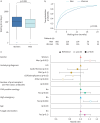Increased delay to lung transplantation for women candidates: gender-based disparity matters in the lung transplant trajectory
- PMID: 40337341
- PMCID: PMC12053738
- DOI: 10.1183/23120541.00623-2024
Increased delay to lung transplantation for women candidates: gender-based disparity matters in the lung transplant trajectory
Abstract
Background: Lung transplantation is a highly dynamic segment of solid organ transplantation in which gender plays a central role. Our objective was to investigate the causes of outcome differences between women and men all along the lung transplantation pathway.
Methods: We used data from the French COhort in Lung Transplantation (COLT) study (12 participating lung transplantation centres). Analyses were performed in three phases: baseline clinical characteristics, peri-transplantation period and post-transplantation follow-up.
Results: Overall, 1710 participants (802 women and 908 men) were included in this study. Women were less likely than men to undergo transplantation (91.6% versus 95.6%; p=0.001) and waited longer before transplantation (115 versus 73 days; p<0.001). Female gender and pre-transplantation class I anti-human leukocyte antigen antibodies were identified as independent factors associated with longer waiting time duration. Female transplant recipients commonly received lungs from height- and sex-matched donors, despite higher female waiting list mortality and a higher proportion of male donors. Importantly, women with oversized lung transplantation (defined by predicted total lung capacity (pTLC) ratio and weight mismatch) did not have worse survival. The overall post-transplantation survival of female recipients was significantly higher than that of male recipients (65.6% versus 57.3%; p<0.001), although the prevalence of specific major lung transplantation outcomes did not differ according to gender.
Conclusion: Women waited longer and were less likely to undergo transplantation. Women transplanted with an oversized lung did not have worse survival after transplantation, suggesting that size matching criteria based on pTLC ratio and weight mismatch may be less stringent in this context.
Copyright ©The authors 2025.
Conflict of interest statement
Conflict of interest: None declared.
Figures





Similar articles
-
Parameters of donor-recipient size mismatch and survival after bilateral lung transplantation.J Heart Lung Transplant. 2012 Nov;31(11):1207-1213.e7. doi: 10.1016/j.healun.2011.07.015. Epub 2011 Oct 28. J Heart Lung Transplant. 2012. PMID: 22036314
-
An oversized allograft is associated with improved survival after lung transplantation for idiopathic pulmonary arterial hypertension.J Heart Lung Transplant. 2013 Dec;32(12):1172-8. doi: 10.1016/j.healun.2013.06.011. Epub 2013 Jul 19. J Heart Lung Transplant. 2013. PMID: 23876630
-
Lung size mismatch in bilateral lung transplantation is associated with allograft function and bronchiolitis obliterans syndrome.Chest. 2012 Feb;141(2):451-460. doi: 10.1378/chest.11-0767. Epub 2011 Jul 28. Chest. 2012. PMID: 21799025 Free PMC article.
-
Three-year survival rates for all consecutive heart-only and lung-only transplants performed in Eurotransplant, 1997-1999.Clin Transpl. 2003:89-100. Clin Transpl. 2003. PMID: 15387100
-
Interventions for preventing thrombosis in solid organ transplant recipients.Cochrane Database Syst Rev. 2021 Mar 15;3(3):CD011557. doi: 10.1002/14651858.CD011557.pub2. Cochrane Database Syst Rev. 2021. PMID: 33720396 Free PMC article.
Cited by
-
Sizing in lung transplantation: principles, practices and ideas for the future.JHLT Open. 2025 May 30;9:100304. doi: 10.1016/j.jhlto.2025.100304. eCollection 2025 Aug. JHLT Open. 2025. PMID: 40606298 Free PMC article. Review.
References
-
- Chambers DC, Cherikh WS, Harhay MO, et al. . The International Thoracic Organ Transplant Registry of the International Society for Heart and Lung Transplantation: Thirty-sixth adult lung and heart–lung transplantation report – 2019; Focus theme: Donor and recipient size match. J Heart Lung Transplant 2019; 38: 1042–1055. doi:10.1016/j.healun.2019.08.001 - DOI - PMC - PubMed
LinkOut - more resources
Full Text Sources
